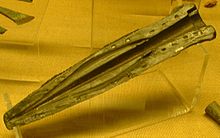Molding or moulding (see spelling differences) is the process of manufacturing by shaping liquid or pliable raw material using a rigid frame called a mold or matrix? This itself may have been made using a pattern or model of the final object.
A mold or mould is a hollowed-out block that is filled with a liquid or pliable material like plastic, glass, metal or ceramic raw materials. The liquid hardens or sets inside the mold, adopting its shape. A mold is the counterpart to a cast. The very common bi-valve molding process uses two molds, one for each half of the object. Piece-molding uses a number of different molds, each creating a section of a complicated object. This is generally only used for larger and more valuable objects.
One half of a bronze mold for casting a socketed spear head dated to the period 1400-1000 BC. There are no known parallels for this mold.
Stone mold of the Bronze Age used to produce spear tips.
The manufacturer who makes the molds is called the moldmaker. A release agent is typically used to make removal of the hardened/set substance from the mold easier. Typical uses for molded plastics include molded furniture, molded household goods, molded cases and structural materials.
Types of molding include:
- Blow molding
- Powder metallurgy plus sintering
- Compression molding
- Extrusion molding
- Injection molding
- Laminating
- Matrix molding
- Rotational molding (or Rotomolding)
- Spin casting
- Transfer molding
- Thermoforming
- Vacuum forming, a simplified version of thermoforming
- Injection molding die with side pulls
- ^ "Molding – Definition of molding by Merriam-Webster. merriam-webster.com.
- ^ "Mold – Definition of mold by Merriam-Webster. merriam-webster.com.
- Wikipedia













No comments:
Post a Comment